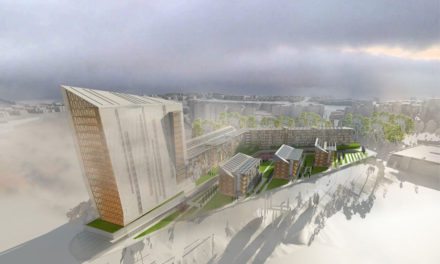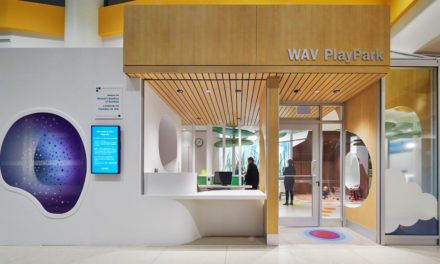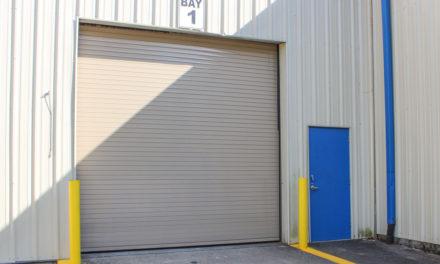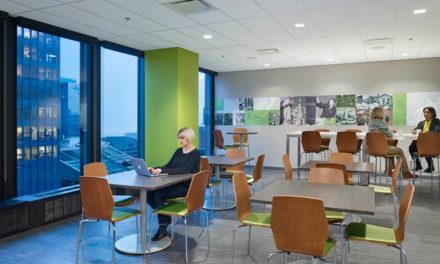New Pathway Helps Streamline and Scale Health and Wellness Upgrades across Portfolios
NEW YORK –– The International WELL Building Institute (IWBI) announced Tuesday the first participants in WELL Portfolio, a new streamlined pathway for WELL Certification for multiple new or existing buildings and tenant spaces in a single portfolio. Being released as part of the WELL v2 pilot, the latest iteration of the WELL Building Standard (WELL), it is part of a suite of enhancements to WELL that addresses growing demand across the building industry for a program that helps owners, developers and tenants streamline and scale health and wellness upgrades to their real estate assets.
The announcement quickly follows the launch of WELL v2, the second iteration of IWBI’s pioneering WELL Building Standard. The addition of an early phase review process enabling projects to seek the WELL D&O designation, introduced in WELL v2, allows portfolio projects to move through the certification process in a more streamlined and systematic fashion across their asset base, with a specific focus on policies, programs and procurement guidelines. The WELL Portfolio Pathway will encourage owners to treat achieving WELL as a journey and not a destination, and to make incremental improvements across their portfolios over time, tracking their progress along the way.
Tenants, developers and investors from Europe, North America, Australia and Asia have all expressed interest in pursuing the WELL Portfolio Pathway. Many have already used WELL for individual buildings and are now looking to bring the same value and evidence-based performance to their portfolios – exemplifying their commitment to improve the health and wellness of people at scale.
Following roundtables, expert-led discussions and stakeholder engagement, organizations from across the globe have committed to piloting a sample portfolio of qualifying buildings. Their hands-on participation in the development of this pathway through the pilot process assures a program that will deliver immediate and measurable benefits to both these early adopters and those who come after.
These organizations include, among others:
- Barclays
- Brandywine Realty Trust
- CBRE Global Investors and CBRE
- Charter Hall
- Forest City Realty Trust
- Gro
- Investa
- JLL Asia Pacific
- The Lendlease managed Australian Prime Property Fund (APPF) Commercial
- Miron Construction Co., Inc.
- Prologis, Inc.
- Shaw Industries
- SL Green Realty Corp
“The excitement around the WELL Portfolio Pathway among the world’s real estate leaders speaks volumes about the need to use our buildings as part of the toolkit to improve our health and enhance our well-being,” says IWBI CEO and Chairman Rick Fedrizzi. “Organizations know that effective change is delivered at scale, and that is the driving force behind this initiative.”
Fedrizzi noted that allowing for a phased implementation of WELL features across multiple buildings in a portfolio can be more efficient and also provide additional flexibility in the ways that owners and landlords can pursue WELL Certification. To enhance efficiency and flexibility, WELL Portfolio Pathway projects will receive custom scorecards, adapted for their respective building portfolios, and will be guided to make portfolio improvements over time. Building owners will also be able to benchmark health and wellness-related building performance, both across their own portfolios and relative to peer portfolios.
Since human and environmental sustainability go hand-in-hand, the WELL Building Standard is designed to be interoperable with leading global green building standards. Developers and property managers who have already made a green building commitment, using LEED, BREEAM, Green Star or Living Building Challenge, for instance, are well-positioned to reap the vast opportunities WELL Certified™ buildings provide.
“Whether it’s building owners looking to further differentiate their spaces to make them more attractive to tenants, or a company looking to retain and attract talent, enhance employee productivity or potentially reduce health care costs, the benefits that come with healthier, more productive employees should far outweigh the one-time investment in building improvements. WELL’s proven performance has become the de facto choice for leaders around the world who want for themselves and their tenants places and spaces designed to deliver immediate and measurable health benefits for every person in the building,” said Fedrizzi.
Participant Quotes
“SL Green has had tremendous success with USGBC’s LEED Volume Program, which allowed us to streamline the certification process across 15 properties so we were able to see the advantages of WELL Portfolio,” said Laura Vulaj, SVP and Director of Sustainability for SL Green. “We are pursuing WELL at One Vanderbilt and we’ll be able to apply lessons learned to this pilot program on a portfolio-wide scale. Most importantly, we are committed to sustaining occupant health and well-being through our partnership with IWBI.”
“JLL Asia Pacific is thrilled to be involved in the WELL Portfolio Pilot, which we are using to focus on JLL’s own property footprint, and to assist our clients in their own journey towards better health and wellbeing,” said Matthew Clifford, Head of Energy and Sustainability Services, JLL Asia Pacific. “This new tool offers great potential to further unlock health and wellness opportunities in the built environment, delivering tremendous benefits to the lives of our staff, clients and the public.”
“Investa sees the health and wellbeing of our tenants as absolutely paramount to creating thriving workplaces across the country and to the success of the organisations we host every day,” said Nina James, General Manager, Corporate Sustainability at Investa. “The portfolio pathway will enable us to articulate best practice health and wellbeing outcomes using the WELL v2 scorecard. Investa is proud to be part of this pilot, working in collaboration with world leading organisations to co create a viable WELL solution for existing buildings.”
“Our participation in the WELL Portfolio Pilot, which integrates employee health and wellness elements into building design, is a natural fit with Prologis’ innovative approach to environmental stewardship, social responsibility and governance,” said Grant Stevens, Managing Director, Global Construction and Development Services, Prologis. “Buildings constructed to the highest sustainable design standards not only reduce operating costs for our customers and our company but also promote employee wellness and productivity.”
“Globally, we are seeing investors apply environmental and social performance, not only to be a good corporate citizen but as an indicator of delivering long-term risk adjusted returns,” said Josh McHutchison, Managing Director of Lendlease Investment Management Australia. “Wellbeing is one of the driving factors for creating the best precincts where people want to work, and our tenants see wellness as a way to attract and retain the very best people.”
“The spaces where we live, work, play, learn and heal have a huge impact on our lives. Their design – as well as the products that go into them – play an important role in how we function every day,” said Susan Farris, Vice President of Sustainability and Corporate Communications at Shaw. “Through our commitment to Cradle to Cradle design principles for the past 20 years, that has been a keen area of focus for us. Our participation in the WELL Portfolio further exemplifies our commitment to human health and wellness through the built environment. Like so many of our clients, we recognize the opportunity to help people thrive and innovate through the safe, healthy workspaces we provide our associates,” Farris continued.




